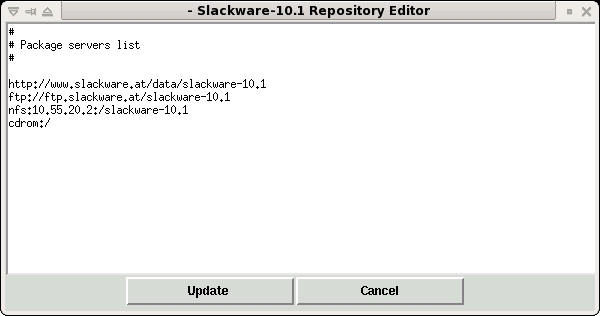
NFS entry is an example only [you must provide a valid NFS server!], http/ftp works and cdrom too. CD-Rom default entry refers to the root of a Slackware 10.1 CD/DVD. Very important: the choosen source MUST point to a Slackware10.1 repository root directory! In other words, if I provide nfs:10.55.20.2/slackware-10.1 the installer mounts the NFS export on /var/log/mount and expects to find: / CHECKSUMS.m5d slackware/ -a/ -ap/ -d/ -e/ -f/ - .... and so on The file CHECKSUMS.m5d is very important because it's used to translate the info on tagfile into package names to be downloaded and installed; this also means that you can create your own mirror with CUSTOM packages, and custom disksets! Kernel: Here we choose the kernel to be used for installation. You need to download some kernels into kernels subdir. You can use original Slackware-10.2 kernels, or any custom kernel, but if you choose the 'custom' way you need built-in support for ethernet card and system disks device. Kernel images can be stored in any directory layout: kernels-\ | [dir] bare.i | \ | bzImage | [dir] scsi.s | \ | bzImage | [dir] adaptec.s | \ | bzImage | [dir] custom | \ | mykernel1 mykernel2 ... You can find some monolithic kernels at http://slack-kickstart.sourceforge.net/kernel Taglist: The list of packages to be installed in Taglist format. the provided tagfile (mini-tag) is a minimal install (about 110MB) and is fully functional. You can create your own taglist, even with custom disksets and packages and put it in Taglists directory! Autoupdate: You can choose none, swaret or slapt-get; in both cases at the end of the installation process, the installer downloads and installs the program and after a chroot, upgrades the installed packages. You will find info about the upgrade process in /var/log. For autoupdates to work, you need: - Network [ to download slapt-get or swaret and the updates! ] - Packages: slapt-get [ bash libidn ] - Packages: swaret [ bash sed grep gawk bc bzip2 ] All the packages needed are included on tagfile mini-tag. Secure: when set to yes, the installer configures only sshd service to be started at boot (no inetd, apache, samba, nfs, bind ... ). Timezone: self explanatory. Keyboard map: self explanatory. Hardware clock: used to know if hardware clock uses GMT or localtime. Email address: when provided, the installed server will send an email every time boots up. It works only if sendmail is installed and running [ Secure = no ]; may not work if destination mailserver checks sender domain and our server has a fake hostname. Autostart: when yes, the installer starts immediatly, else runs the checklist script, then prompts the user to start installation [useful for debug].


